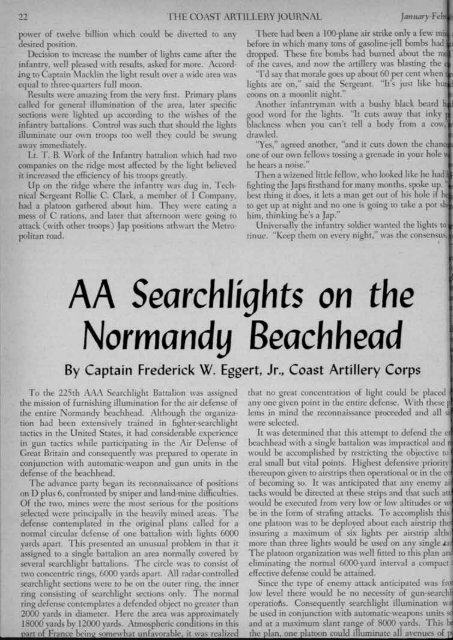January-February - Air Defense Artillery
January-February - Air Defense Artillery
January-February - Air Defense Artillery
You also want an ePaper? Increase the reach of your titles
YUMPU automatically turns print PDFs into web optimized ePapers that Google loves.
22<br />
power of twelve billion which could be di\'erted to any<br />
desired position.<br />
Decision to increase the number of lights came after the<br />
infantry, well pleased with results, asked for more. Accord-<br />
.ing to Captain 1\ lacklin the light result over a wide area was<br />
equal to three-quarters full moon.<br />
Results were amazing from the \'ery first. Primary plans<br />
called for general illumination of the area, later specific<br />
sections were lighted up according to the wishes of the<br />
infantry battalions. Control was such that should the lights<br />
illuminate our own troops too well they could be swung<br />
away immediately.<br />
Lt. 1'. B. \ Vork of the lnfantrv battalion which had two<br />
companies on the ridge most aff~cted by the light belie\'ed<br />
it increased the efficiency of his troops greatly.<br />
Up on the ridge where the infantry was dug in, Technical<br />
Sergeant Rollie C. Clark, a member of I Company.<br />
had a platoon gathered about him. They were eating a<br />
mess of C rations, and later that afternoon were ooino to<br />
/:) /:)<br />
attack (with other troops) Jap positions athwart the l\ letropolitan<br />
road.<br />
THE COAST ARTILLERY JOUR:'\AL<br />
}mlllM) -Fe<br />
There had been a lOO-plane air strike only a few mi ,<br />
before in which many tons of gasoline-jell bombs had I<br />
dropped. These fire bombs had burned about the m<br />
of the caves. and now the artillery was blasting the<br />
''I'd say that morale goes up about 60 per cent when!<br />
liohts are on," said the Sergeant. "It's just like hu I<br />
o ~.<br />
coons on a moonlit night." l<br />
Another infantryman with a bush v black beard<br />
oood word for th~ liohts. "It cuts ~wav that inkY<br />
/:) "<br />
,.<br />
blackness when \'OU can't tell a body from a co\\'. I<br />
drawled ..<br />
"Yes," agreed another, "and it cuts down the chan t<br />
one of our own fellows tossino a oorenade in vour hole II<br />
/:) ,<br />
he hears a noise."<br />
Then a wizened little fellow. who looked like he had<br />
fighting the Japs firsthand for many months, spoke up. '<br />
best thing it does, it lets a man get out of his hole if he<br />
to get up at night and no one is going to take a pot sh<br />
him. thinking he's a Jap."<br />
Universally the infantry soldier wanted the lights to<br />
tll1ue. . "Keep tI 1em on even' 01011, . I" was tI1e consensus .<br />
• 0 ,<br />
AA Searchlights on the<br />
Normandy Beachhead<br />
By Captain Frederick W. Eggert, Jr., Coast <strong>Artillery</strong> Corps<br />
To the 225th AAA Searchlight Battalion was assigned<br />
the mission of furnishing illumination for the air defense of<br />
the entire Normandy beachhead. Although the organization<br />
had been extensively trained in fighter-searchlight<br />
tactics in the United States, it had considerable experience<br />
in gun tactics while participating in the <strong>Air</strong> <strong>Defense</strong> of<br />
Great Britain and consequently was prepared to operate in<br />
conjunction with automatic-weapon and gun units in the<br />
defense of the beachhead.<br />
The advance party began its reconnaissance of positions<br />
on D plus 6, confronted by sniper and land-mine difficulties.<br />
Of the two, mines were the most serious for the positions<br />
selected were principally in the heavily mined areas. The<br />
defense contemplated in the original plans called for a<br />
normal circular defense of one battalion with lights 6000<br />
yards apart. This presented an unusual problem in that it<br />
assigned to a single battalion an area normally covered by<br />
several searchlight battalions. The circle was to consist of<br />
two concentric rings, 6000 yards apart. All radar-controlled<br />
searchlight sections were to be on the outer ring, the inner<br />
ring consisting of searchlight sections only. The normal<br />
ring defense contemplates a defended object no greater than<br />
2000 yards in diameter. Here the area was approximately<br />
18000 yards by 12000 yards. Atmospheric conditions in this<br />
art of France beino somewhat unfavorable. it was realized<br />
tbat no great concentration of light could be placed<br />
anyone given point in the entire defense. \Vitb these<br />
lems in mind the reconnaissance proceeded and all si<br />
were selected.<br />
It was determined that this attempt to defend the e<br />
beachhead with a single battalion was impractical and<br />
would be accomplished by restricting the objective to<br />
eral small but vital points. Highest defensive priority<br />
thereupon given to airstrips then operational or in the c<br />
of becoming so. It was anticipated that any enemy ai<br />
tacks would be directed at these strips and that such at!<br />
would be executed from very low or low altitudes or IV<br />
be in the form of strafing attacks. To accomplish this<br />
one platoon was to be deployed about each airstrip the<br />
insuring a maximum of six lights per airstrip altha<br />
more than three lights would be used on any single_a<br />
The platoon organization was well fitted to this plan an<br />
eliminating the normal 6000-yard interval a compact<br />
effective defense could be attained.<br />
Since the type of enemy attack anticipated was fr<br />
low level there would be no necessity of gun-searchl<br />
cperatiofls. Consequently searchlight illumination \\'3<br />
be used in conjunction with automatic-weapons units s<br />
and at a maximum slant range of 8000 yards. This<br />
the lan, one latoon could illuminate all avenues of
















